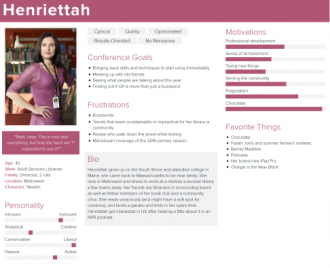Identifying Your Library’s Users
We’ve been throwing the term “user experience” around but we haven’t taken a look at exactly who the ‘U’ in UX is. One of the critical steps in the UX process is identifying who your users are. Depending on the type of library you work in, these groups might apply: patrons (or customers, or whatever you call them; students; faculty; nonresidents; and staff.
Each of these groups can be broken down further. For example, in an academic library you might have undergraduate students and graduate students, or students from different colleges or disciplines. Staff will encompass professional and paraprofessional staff, or union and exempt, or faculty and non-faculty. Patrons in public libraries are wildly diverse: adults, young adults, seniors, teens, tweens, children and preschoolers; new residents, early readers, people with disabilities, and more. I worked for years in public libraries in resort towns, with special patron groups such as second homeowners and seasonal workers. Every one of these groups has differing and sometimes competing needs and preferences.
So how do you break it down?
One tool that can be of enormous help in defining your users is the persona. A persona is a representation of a major user group in your library. You’ll have to develop several personas in order to capture the majority of users, and some patrons will fit into more than one. Here is an example of a persona that was created when I was helping develop a UX session for a library conference:
Click on the thumbnail to see the persona within the Resource Guide “Elements of UX: a Librarian’s Guide to User Experience Design.” This graphic was developed using Xtensio, a free persona generator. Note that only a few of the characteristics are specific to the project at hand. The goal is to create a deep and rounded understanding of the user, drawing on and deepening empathy. You can tell that we had fun creating Henriettah. When developing personas you can use in-depth interviews and focus groups to get a better handle on the details, rather than making assumptions.
You may think you already know your users – sometimes too well – but it’s worth your time to consider what you don’t know and dig a little deeper. You will likely be surprised at what you find.
Tags: customer experience, library users, library ux, user experience, ux













